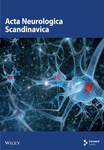Classical Alzheimer features and cholinergic dysfunction: towards a unifying hypothesis?
Abstract
Objective – Our autopsy studies show possible links between classical Alzheimer pathology and decreased expression of nicotinic acetylcholine receptors. For further elucidation we are now using in vitro models. We report preliminary evidence for the impact of β-amyloid on nicotinic receptor expression in hippocampal dissociation culture. Methods – Cultures (E18 rats) were grown in a serum-free medium and incubated at 8 days in vitro for 3 days with 1 µM Aβ1–42. Expression of α4, α7, and β2 nicotinic receptor subunit protein was assessed immunohistochemically and rated semiquantitatively. Results – Aβ1–42 incubation resulted in a massive reduction of α4 protein-expressing neurons, this effect was less pronounced for the α7 and β2 subunit protein. Conclusion – These findings provide first evidence for a direct impact of classical Alzheimer pathology features on nicotinic receptor expression in vitro. Our model will be useful for testing the potential of drugs to stop or reverse these effects.




